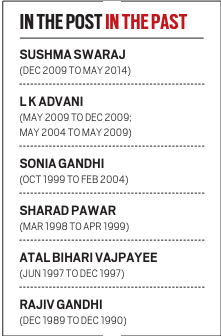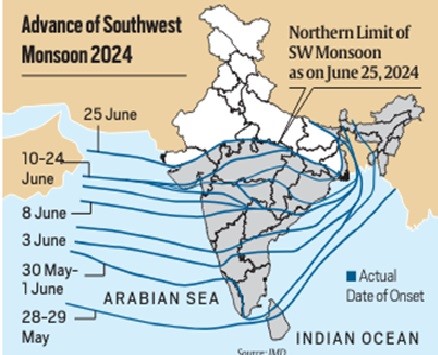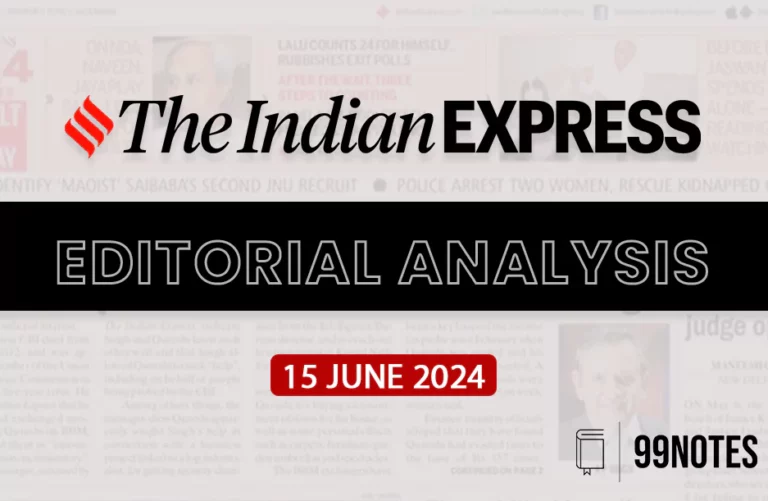27 June 2024 : Daily Current Affairs
1. Prolonged exposure to coal mining causes respiratory, skin diseases in workers: study
(Source – The Hindu, International Edition – Page No. – 6)
| Topic: GS2 – Social Justice – Health |
| Context |
|
Analysis of the news:
- A survey by the National Foundation for India highlighted health issues among residents in six major coal mining districts in India: Koriya and Raigarh (Chhattisgarh), Dhanbad and Ramgarh (Jharkhand), and Angul and Jajpur (Odisha).
- 65% of households reported respiratory diseases like chronic bronchitis and asthma, as well as skin ailments such as eczema and dermatitis.
- Medical expenses ranged from ₹300 to ₹1,000 per month per household, with Dhanbad recording the highest annual hospitalisation costs at ₹28,461.
- Proximity to mines increased health risks, particularly in Dhanbad and Ramgarh.
- The study advocated for a ‘just transition’ from coal mining, anticipating economic challenges and job losses due to global shifts towards renewable energy.
- India aims to source 500 GW of electricity from renewables by 2030, although coal still dominates with about 205 GW capacity, despite a recent decline below 50% in total power generation.
| Health risks associated with coal mine workers: |
|
| PYQ: Mumbai, Delhi and Kolkata are the three megacities of the country but the air pollution is a much more serious problem in Delhi as compared to the other two. Why is this so? (200 words/12.5m) (UPSC CSE (M) GS-1 2015) |
| Practice Question: Discuss the health risks faced by coal mine workers and their implications on occupational health in India. How can effective regulatory measures mitigate these risks? (250 Words /15 marks) |
2. ‘Multi-omics’ is transforming how India spots and treats TB, cancers
(Source – The Hindu, International Edition – Page No. – 7)
| Topic: GS2 – Governance – Government Policies, GS3 – Science and Technology |
| Context |
|
Analysis of the news:
- Genomics Revolution in India: Over the past decade, India has seen a transformative shift in utilising genomics for diagnosing, managing, and treating diseases like tuberculosis, cancers, and antimicrobial resistance.
- Genome India Project: Launched by the Department of Biotechnology, this project aims to sequence 10,000 genomes from 99 ethnic groups to create a reference genome for Indians. It facilitates low-cost diagnostics and disease-specific genetic chips.

- IndiGen Initiative: Led by CSIR, this project sequenced 1,008 genomes to analyse genetic diseases epidemiology, optimise treatments, and develop affordable screening methods.
- Disease-Specific Consortia: Various consortia across India focus on diseases such as tuberculosis, cancers, rare genetic disorders, and antimicrobial resistance using genomic insights.
- Tuberculosis Genomics: The Indian Tuberculosis Genomic Surveillance Consortium (InTGS) aims to sequence 32,000 clinical strains, map genetic diversity, and correlate mutations with drug resistance patterns.
- Rare Genetic Disorders: Mission PRaGeD targets paediatric rare genetic disorders, integrating IndiGen data for genetic diagnosis, counselling, and therapy development.
- Cancer Genomics: The Indian Cancer Genome Consortium (ICGC-India) studies genomic abnormalities, biomarkers, and treatment responses in Indian cancer patients.
- Antimicrobial Resistance: Genomics aids in understanding antimicrobial resistance and guiding antibiotic therapies without needing to culture slow-growing pathogens.
- AI and ML Integration: Artificial intelligence and machine learning enhance genomic data analysis, predict disease risks, develop diagnostic tools, and personalise treatment strategies.
- Multi-Omics Approach: Integrating genomics with proteomics, transcriptomics, and epigenomics enables a comprehensive approach to clinical science, enhancing disease understanding and management in India.

| What is Multi-Omics Approach? |
|
The Multi-Omics Approach integrates data from multiple biological disciplines such as genomics, transcriptomics, proteomics, and epigenomics to comprehensively study biological systems. It aims to understand complex interactions among genes, proteins, and other molecules to unravel disease mechanisms, discover biomarkers, and develop personalised treatments in medicine and healthcare. Advantages:
|
| Practice Question: Discuss the role of genomics in transforming healthcare diagnostics and treatment in India. How can initiatives like Genome India and disease-specific consortia contribute to addressing public health challenges? (250 Words /15 marks) |
3. How well is India tapping its rooftop solar potential?
(Source – The Hindu, International Edition – Page No. – 10)
| Topic: GS3 – Indian Economy – Infrastructure – Energy |
| Context |
|
Analysis of the news:
RTS Capacity Growth: India’s rooftop solar (RTS) capacity increased by 2.99 GW in 2023-2024, reaching a total of 11.87 GW by March 31, 2024, marking significant growth.
Jawaharlal Nehru National Solar Mission: Launched in 2010, aimed to achieve 20 GW solar capacity in phases; revised to 100 GW by 2022, including 40 GW from RTS. Deadline extended to 2026 due to challenges.
State Performances: Gujarat leads with 3,456 MW RTS capacity, Maharashtra follows with 2,072 MW, and Rajasthan with 1,154 MW due to streamlined processes and supportive policies.
Challenges in States: Uttar Pradesh, Bihar, Jharkhand lag due to bureaucratic hurdles, infrastructure gaps, and low awareness hindering RTS adoption.
Pradhan Mantri Surya Ghar Muft Bijli Yojana: Aims to install RTS in one crore households, providing up to 300 units of free electricity monthly, contributing 20 GW RTS capacity with ₹75,021 crore outlay.
Ensuring RTS Growth:
- Awareness and Viability: Essential for consumer adoption; subsidies and low-cost financing options needed.
- Research and Development: Focus on solar technology, energy storage, and smart grids to enhance efficiency and reliability.
- Skill Development: Initiatives like ‘Suryamitra’ program crucial for building a skilled workforce.
- Regulatory Framework: Reviewing net-metering, grid-integration, and building codes to support smooth implementation and address challenges.
Future Goals: RTS to contribute about 100 GW to India’s 500 GW renewable energy target by 2030; comprehensive strategy needed for sustained growth and achievement of targets.
| Rooftop Solar Systems: |
|
Benefits:
Challenges:
Way Forward:
|
| PYQ: India has immense potential of solar energy though there are regional variaSons in its development. Elaborate. (250 words/15m) (UPSC CSE (M) GS-1 2020) |
| Practice Question: Discuss the potential benefits, challenges, and strategies for promoting rooftop solar energy in India. How can effective policy measures and technological advancements accelerate its adoption? (250 Words /15 marks) |
4. Rahul Gandhi Takes Charge as Leader of Opposition in Lok Sabha: Understanding the Role and Its Historical Context
(Source: Indian Express; Section: Explained; Page: 09)
| Topic: GS2 – Polity – Parliament |
| Context: |
|
Analysis of News

The Role and Recognition of the Leader of Opposition:
- In 2014, Mallikarjun Kharge, now Congress president and Leader of Opposition in Rajya Sabha, was recognised as the Leader of the Congress party in Lok Sabha.
- In 2019, this position went to Baharampur MP Adhir Ranjan Chowdhury. Both leaders were part of panels to select candidates for high positions requiring the presence of the Leader of Opposition.
- The position of Leader of Opposition was officially described in The Salary and Allowances of Leaders of Opposition in Parliament Act, 1977.
- The Act defines the Leader of Opposition as the leader in that House of the party in opposition to the government having the greatest numerical strength and recognised as such by the Chairman of the Council of States or the Speaker of the House of the People.
- Former Lok Sabha Secretary General P.D.T. Achary clarified that the Speaker is required to recognise the leader of the numerically largest party in opposition as the Leader of Opposition, rejecting the conventional understanding that a party must have at least 10% of MPs in the House.
Responsibilities and Privileges of the Leader of Opposition
- The Leader of Opposition sits in the front row to the left of the Chair and enjoys certain privileges on ceremonial occasions.
- The main duty of the Leader of Opposition is to serve as the voice of the opposition in the House.
- An official booklet on Parliament states that the Leader of Opposition in Lok Sabha is considered a shadow Prime Minister with a shadow Cabinet, ready to take over the administration if the Government resigns or is defeated on the floor of the House.
Practical Role and Influence of the Leader of Opposition:
- The Leader of Opposition plays a crucial role in high-powered committees headed by the Prime Minister for appointments to key positions such as the Director of CBI, the Central Vigilance Commissioner, and the Chief Information Commissioner.
- As the Leader of the Congress in Lok Sabha from 2014 to 2019, Kharge alleged that the government repeatedly tried to keep the opposition out of the selection of the Lokpal on the ground that there was no Leader of Opposition.
Order of Precedence and Current Dynamics:
- In the order of precedence, the Leaders of Opposition in Lok Sabha and Rajya Sabha come at No. 7, along with Union Cabinet Ministers, the National Security Advisor, the Principal Secretary to the PM, the Vice-Chairperson of the NITI Aayog, former PMs, and Chief Ministers.
- With Rahul Gandhi now occupying this significant role, the dynamics of opposition and governance in the Lok Sabha are set to see impactful changes.
| Practice Question: Discuss the significance and responsibilities of the Leader of Opposition in the Indian Parliament. How does the position contribute to the functioning of a democratic government, and what challenges has it faced historically? (250 words/15 m) |
5. Monsoon Set to Rapidly Advance Across India, Bringing Heavy Rainfall and Relief from Heat
(Source: Indian Express; Section: Express Network; Page: 07)
| Topic: GS1 – Geography |
| Context: |
|
Analysis of News:

Regions Covered by the Monsoon
- The IMD predicts that the monsoon will entirely cover Gujarat, Madhya Pradesh, Chhattisgarh, Jharkhand, Bihar, and West Bengal.
- Additionally, it will advance into more areas of east and west Uttar Pradesh, Uttarakhand, Himachal Pradesh, Jammu & Kashmir, Ladakh-Gilgit-Baltistan-Muzaffarabad, and the northern parts of Punjab and Haryana by June 29.
- This swift progression marks a significant milestone in the monsoon season.
Factors Influencing South-West Monsoon Formation
- The differential heating and cooling of land and water creates a low pressure on the landmass of India while the seas around experience comparatively high pressure.
- The shift of the position of Inter Tropical Convergence Zone (ITCZ) in summer, over the Ganga plain (this is the equatorial trough normally positioned about 5°N of the equator. It is also known as the monsoon-trough during the monsoon season).
Inter Tropical Convergence Zone
The Inter Tropical Convergence Zone (ITCZ,) is a broad trough of low pressure in equatorial latitudes. This is where the northeast and the southeast trade winds converge. This convergence zone lies more or less parallel to the equator but moves north or south with the apparent movement of the sun.
- The presence of the high-pressure area, east of Madagascar, approximately at 20°S over the Indian Ocean. The intensity and position of this high-pressure area affect the Indian Monsoon.
- The Tibetan plateau gets intensely heated during summer, which results in strong vertical air currents and the formation of low pressure over the plateau at about 9 km above sea level.
- The movement of the westerly jet stream to the north of the Himalayas and the presence of the tropical easterly jet stream over the Indian peninsula during summer.
- Tropical Easterly Jet (African Easterly Jet).
- Southern Oscillation (SO): Normally when the tropical eastern south Pacific Ocean experiences high pressure, the tropical eastern Indian Ocean experiences low pressure. But in certain years, there is a reversal in the pressure conditions and the eastern Pacific has lower pressure in comparison to the eastern Indian Ocean. This periodic change in pressure conditions is known as the SO.
El Nino
- This is a name given to the periodic development of a warm ocean current along the coast of Peru as a temporary replacement of the cold Peruvian current. ‘El Nino’ is a Spanish word meaning ‘the child’, and refers to the baby Christ, as this current starts flowing during Christmas.
- The presence of the El Nino leads to an increase in sea-surface temperatures and weakening of the trade winds in the region.
Mechanism
Onset of the South-West Monsoon
- The location of ITCZ shifts north and south of the equator with the apparent movement of the Sun.
- During the month of June, the sun shines vertically over the Tropic of Cancer and the ITCZ shifts northwards.
- The southeast trade winds of the southern hemisphere cross the equator and start blowing in southwest to northeast direction under the influence of Coriolis force.
- These winds collect moisture as they travel over the warm Indian Ocean.
- In the month of July, the ITCZ shifts to 20°-25° N latitude and is located in the Indo-Gangetic Plain and the south-west monsoons blow from the Arabian Sea and the Bay of Bengal. The ITCZ in this position is often called the Monsoon Trough.
- The shift in the position of the ITCZ is also related to the phenomenon of the withdrawal of the westerly jet stream from its position over the north Indian plain, south of the Himalayas.
- The easterly Jet Stream (Somali Jet) sets in along 15°N latitude only after the western jet stream has withdrawn itself from the region. This easterly jet stream is held responsible for the burst of the monsoon in India.
As these winds approach the land, their southwesterly direction is modified by the relief and thermal low pressure over northwest India. The monsoon approaches the Indian landmass in two branches:
- The Arabian Sea branch – The monsoon winds originating over the Arabian Sea.
- The Bay of Bengal branch – The Arakan Hills along the coast of Myanmar deflect a big portion of this branch towards the Indian subcontinent. The monsoon, therefore, enters West Bengal and Bangladesh from south and southeast instead of from the south-westerly direction.
Another phenomenon associated with the monsoon is its tendency to have ‘breaks’ in rainfall. The monsoon rains take place only for a few days at a time. They are interspersed with rainless intervals. These breaks in monsoon are related to the movement of the monsoon trough.
| Practice Question: Discuss the significance of the Southwest monsoon’s rapid advancement across India. How does it affect agriculture, water resources, and regional weather patterns? Analyze the preparedness required to mitigate potential risks associated with heavy rainfall during this monsoon season. (250 words/15 m) |
Prelims Facts
1. U.S. criticises India in report on religious freedom
(Source – The Hindu, International Edition – Page No. – 1)
| Context |
|
Analysis of the news:
- The U.S. published a report on Wednesday criticizing India, a close partner, on religious freedom.
- Secretary of State Antony Blinken highlighted concerns about anti-conversion laws, hate speech, and demolition of homes and places of worship affecting minority faith communities in India.
- The report also noted a sharp increase in anti-Semitism and Islamophobia in the U.S. related to the Gaza war.
- Despite public criticism, significant action from the State Department against India is not anticipated in the upcoming annual religious freedom blacklist.
- The report raised concerns about Pakistan’s blasphemy laws, which foster intolerance and can incite vigilantism and mob violence.
- Blinken mentioned a dramatic rise in hate crimes against Muslims and Jews in the U.S.
- Nine European nations were noted for effectively banning some forms of religious clothing in public spaces, with France leading restrictions on full-face veils worn by Muslim women.
2. India’s largest leopard safari opens at Bannerghatta
(Source – The Hindu, International Edition – Page No. – 3)
| Context |
|

Analysis of the news:
- Karnataka Environment Minister inaugurated South India’s first and India’s largest leopard safari at Bannerghatta Biological Park.
- The safari spans 20 hectares with eight leopards released in a natural forest setting.
- Costing ₹4.5 crore, the safari features rocky terrain and semi-deciduous forest with a 4.5-meter high chain-link mesh and MS sheets for safety.
- Aimed at highlighting leopards and addressing human-animal conflict, the park rescues leopard cubs for educational purposes.
- Additionally, new facilities include a renovated elephant weaning centre, babycare room, children’s play area, and electric buggies.
- Future plans involve naturalistic enclosures for emus, rheas, a cheetah enclosure, baboon enclosures, and a wolf enclosure, along with skywalks linking the zoo and butterfly park.
3. Mumbai-Born Writer Sanjana Thakur Wins Commonwealth Short Story Prize for “Aishwarya Rai”
(Source: Indian Express; Section: The Second Page; Page: 02)
| Context: |
|
Analysis of News:
About Commonwealth Foundation:
- The Commonwealth Foundation is an intergovernmental organisation mandated by its Member States to advance the interests of Commonwealth civil society.
- Upholding a firm commitment to the principles and ideals of the Commonwealth, the Foundation seeks to nurture the growth of vibrant and free societies: championing the active and constructive participation of people in all aspects of governance.
Vision
- A Commonwealth of equal, just and inclusive societies.
Mission
- Supporting the active and constructive participation of Commonwealth citizens in all aspects of their governance
- Nurturing the growth of vibrant and free civil societies in all Commonwealth countries
- Advancing the principles and ideals of the Commonwealth
Value addition/Mains Fodder points:
Term in the news:
- Gender Washing:
- Gender washing refers to the practice of making false or exaggerated claims about a product, service, or policy being gender-neutral, gender-inclusive, or empowering to a particular gender, when in fact it may not be.
- For example, a company might highlight its support for women in leadership roles during International Women’s Day while continuing to pay female employees less than their male counterparts or failing to address workplace harassment issues.
- The term criticizes the use of gender-related initiatives as a facade to improve public perception without genuine commitment to systemic change.
Important Quotes for UPSC Mains:
- “Freedom Cannot be achieved unless women have been emancipated from all its kinds of oppression.”
-Nelson Mandela



